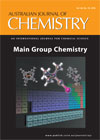
Australian Journal of Chemistry
Volume 66 Number 10 2013
Main Group Chemistry
CH13429Modern Main Group Chemistry: From Renaissance to Revolution
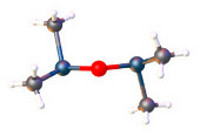
This collection of papers highlights the resurgence of main group chemistry in the last 30 years and its relevance to chemistry in Australia and the world.
CH13256The Fifth Element in Drug Design: Boron in Medicinal Chemistry

Current boron-containing therapeutics and recent advances in the medicinal chemistry of boronic acid derivatives, 1,2-azaborines, and icosahedral carboranes are highlighted and illustrated with selected examples. The future potential of these boron-based structural motifs for medicinal chemistry is described.
CH12560Bicyclic Guanidinates in Mono- and Di-Valent Metal Complexes, Including Group 1/2 and Group 1/12 Heterometallic Systems
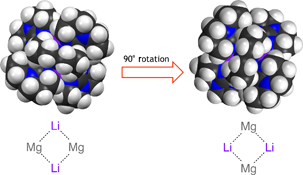
Complexes containing mono-, di-, and mixed mono-/di-valent metal centres supported by [hpp]– are reported, including heterobimetallic mixed lithium–magnesium and lithium–zinc heterometallic examples (hppH = 1,3,4,6,7,8-hexahydro-2H-pyrimido[1,2-a]pyrimidine).
CH13115‘Classical’ and ‘Abnormal’ Bonding in Tin (II) N-Heterocyclic Carbene Complexes
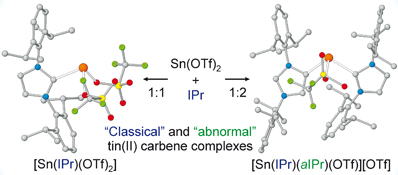
Reaction of Sn(OTf)2 (OTf– = OSO2CF3–) with one and two equivalents of 1,3-bis(2,6-diisopropylphenyl)-imidazol-2-ylidene (IPr) yielded the complexes [Sn(IPr)(OTf)2] (1) and [Sn(IPr)(aIPr)(OTf)][OTf] (2), respectively. Both compounds display an NHC ligand bonded to tin(ii) via the C2 carbon in a ‘classical’ mode, while 2 also contains an ‘abnormal’ C4/C5-bonded carbene.
CH13185Homo- and Heteroleptic 8-Quinaldinolate Complexes From Elevated-temperature Rearrangements
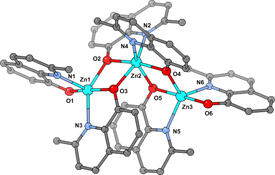
Three new zinc 8-quinaldinolate (MQ) complexes have been obtained from rearrangement reactions at elevated temperatures including the first homoleptic zinc 8-quinaldinolate complex, [Zn3(MQ)6], and two tetranuclear, heteroleptic MQ/Cl complexes [Zn4Cl4(MQ)4] and [Zn4Cl2(MQ)6].
CH13175Extremely Bulky Amido and Amidinato Complexes of Boron and Aluminium Halides: Synthesis and Reduction Studies
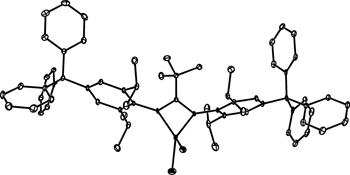
A series of extremely bulky amido and amidinato ligands have been synthesised and used in the preparation of boron(iii) and aluminium(iii) halide complexes. Efforts to reduce these complexes to monomeric group 13 element(i) species are described.
CH13141Phosphenium-Insertion and Chloronium-Addition Reactions Involving the cyclo-Phosphanes (t-BuP)n (n=3, 4)

The cyclo-phosphanes (t-BuP)n (n = 3, 4) were used in the syntheses of cyclo-phosphanylphosphonium ions by introducing Ph2P+ or chloronium. The dependency of such reactions on the presence of GaCl3 or Me3SiOTf as a chloride abstracting agent is discussed. In addition, a Me3SiOTf-mediated ring expansion reaction of (t-BuP)3 to (t-BuP)4 is unveiled.
CH13196N-Heterocyclic Silylene (NHSi) Rhodium and Iridium Complexes: Synthesis, Structure, Reactivity, and Catalytic Ability

Facile entry to novel N-heterocyclic silylene (NHSi) group 9 metal complexes of the type [L(Cl)Si:→M(Cl)cod] (L = [HC(CMeNAr)2], Ar = 2,6-iPr2C6H3, M = Rh and Ir, cod = 1,5-cyclooctadiene) is reported. Their ability to catalytically reduce amides is also presented, along with their contrasting reactivity patterns to nucleophiles.
CH13220Luminescent P-Benzyl Dithienophospholes – A Joint Experimental and Theoretical Investigation
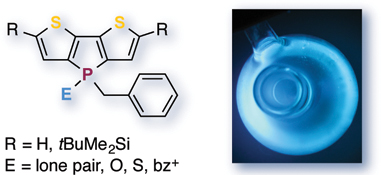
π-Conjugated organophosphorus compounds can generally exhibit quite unique photophysical and electronic properties. This contribution reports on the synthesis and characterisation of a series of new luminescent P-benzyl dithienophospholes, as well as their modification at the scaffold and the P-centre. Density functional theory calculations that support the experimental findings are also included.
CH13202On the Bonding in Bis-pyridine Iodonium Cations

A combined theoretical and synthetic study on the classic bis-pyridine iodine cation reveals that the N–I bond can be considered as a dative bond, and hence the cation can be thought of as a coordination complex. This is in contrast to the bonding in the lighter halide derivatives, where the N–X bond is best considered as a standard covalent bond.
CH13157Contrasting Reactivity of Mono- versus Bis-2,2,6,6-tetramethylpiperidide Lithium Aluminates Towards Polydentate Lewis Bases: Co-Complexation Versus Deprotonation
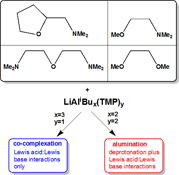
A variety of aliphatic ligands containing multiple Lewis donor atoms have been studied in reactions with the lithium aluminate bases LiAl(TMP)iBu3 and LiAl(TMP)2 iBu2 (TMP = 2,2,6,6-tetramethylpiperidide). With the former alkyl rich base, only Lewis acid–Lewis base interactions between the bimetallic base and the ligand are observed, whereas the stronger bis-amido base can bring about aluminodeprotonation of the attached polydentate donor molecule.
CH13122Characterisation of Germanium Monohalides by Solid-State NMR Spectroscopy and First Principles Quantum Chemical Calculations
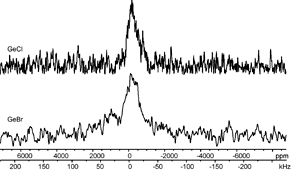
The novel germanium(i) halides GeBr and GeCl were studied by 35Cl, 79Br, and 73Ge solid-state NMR spectroscopy. The data, combined with the results of DFT calculations in Gaussian 09 and plane wave pseudopotential calculations in CASTEP, were used to suggest a possible structure for these amorphous compounds. The monohalides are proposed to be linear head-to-tail oligomers of GeX units, terminated by an inverted GeX unit giving rise to a Ge–Ge bond.
CH13106Synthesis and Reactivity of Half-Sandwich Ruthenium κ2-Aminoborane Complexes
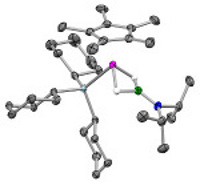
Cationic half-sandwich ruthenium complexes of the type [Cp*Ru(L)(κ2-H2BNR2)][BArf4] (L = PCy3, PPh3, 1,3-bis-(2,4,6-trimethylphenyl)-imidazol-2-ylidene; R = iPr, Cy) can readily be accessed from 16-electron precursors via chloride abstraction in the presence of H2BNR2. The κ2-binding mode of the aminoborane ligand in three cases was determined in the solid state by X-ray crystallography.
CH13229Aluminium Complexes of a Sterically Demanding Bis(iminophosphorane)methandiide

Rare metal-carbon bonded complexes such as methandiide complexes are of fundamental importance in molecular organometallic and inorganic chemistry. The synthesis and characterisation of sterically demanding methandiide aluminium complexes are described. Derivatisation chemistry on aluminium and different coordination modes for a methandiide ligand to two aluminium centres are reported.
CH13244Synthesis, Structure, NMR Spectroscopy, and Electrochemistry of the Sterically Congested Triarylarsine Dipp3As: EPR Characterization of its Radical Cation
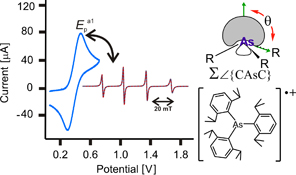
Oxidation of the title compound >0.4 V v. Fc+/0 produces the persistent radical Dipp3As+• which was unambiguously characterised by fluid and frozen solution EPR spectroscopy. Consideration of the A and B hyperfine parameters confirms that the ground state geometry is slightly pyramidal with ∑∠{CAsC} ≈ 351°.
CH13209Preparation and Structures of Group 12 and 14 Element Halide–Carbene Complexes
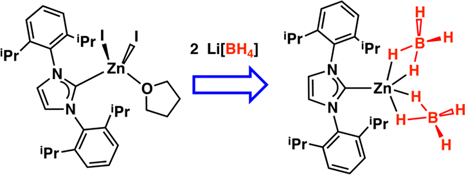
Various complexes between N-heterocyclic carbene donors and element halides of Group 12 and 14 (Zn, Cd, Ge, Sn, and Pb) are reported along with their reactivity with various hydride sources.
CH13262Heterotopic As,S,P and As,S,As Ligands: Synthesis and Theoretical Studies
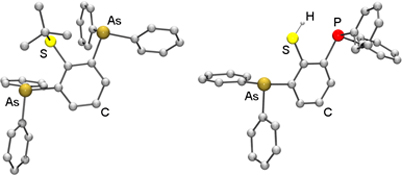
The heterotopic As,S,P ligands 1-AsPh2-2-StBu-3-PPh2-C6H3 and 1-AsPh2-2-SH-3-PPh2-C6H3 and dinucleating As,S,As ligand 1,3-(AsPh2)2-2-StBu-C6H3 have been synthesized and characterized. The structural motif of these compounds suggests great potential for their use as monodentate, bidentate chelating, bidentate bridging, and tridentate ligands.
CH13227Nucleophilic Aromatic Substitution of Bis(pentafluorophenyl)mercury with Various Bulky Nucleophiles and the Structures of [Hg(C6F4X-4)2] (X=cyclo-C5H10N, OCH(CH3)2, OC(CH3)3)
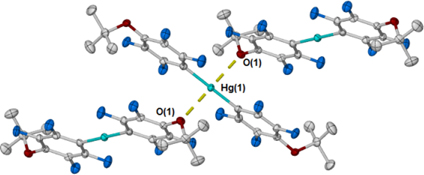
Reactions of bis(pentafluorophenyl)mercury with piperidine, sodium iso-propoxide, or sodium tert-butoxide have yielded the corresponding 4-substituted tetrafluorophenylmercurials, [Hg(C6F4X-4)2] (X = cyclo-C5H10N (1), OCH(CH3)2 (2), OC(CH3)3 (3)), in reasonable yields but the bulkier nucleophiles, cis-2,6-dimethylpiperidine and 2,6-di-iso-propylphenolate (from sodium 2,6-di-iso-propylphenolate), decomposed the mercurial into pentafluorobenzene.
CH13314Unusual Potassium-η2-Aromatic Interactions in the Crystal Structure of the Diphenylarsenide Transfer Reagent, KAsPh2·2(1,4-Dioxane)
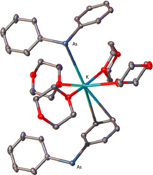
Ethene elimination in the metallation of 1,2-bis(diphenylarsino)ethane in 1,4-dioxane gave only a poor yield of [KAsPh2]•2(1,4-dioxane) which was characterised structurally.
CH13259Calcium-mediated Hydrophosphorylation of Organic Isocyanates with Diphenylphosphane Oxide
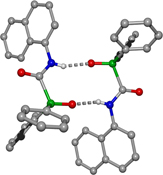
Calcium-mediated addition reactions of diphenylphosphane oxide to organic isocyanates and -thioisocyanates yield the corresponding N-organyl-diphenylphosphorylformamidinates as well as -thioformamidinates. These compounds form dimers by N–H···O–P hydrogen bridges (broken lines; C grey, N blue, O red, P green).
CH13226The Effect of Solvent on the Morphology of Indium Oxide Deposited by Aerosol-assisted Chemical Vapour Deposition

Thin films of indium oxide have been grown using a solution-based chemical vapour deposition (CVD) technique, aerosol-assisted CVD. The use of methanol as the solvent has been shown to influence the microstructure of the resulting film in comparison with using toluene as the solvent.
CH13260Cu3(µ2-Cl)3 and Ag3(μ2-Cl)3 Complexes Supported by Tetradentate Trisphosphino-stibine and -bismuthine Ligands: Structural Evidence for Triply Bridging Heavy Pnictines

The complexes (o-(iPr2P)C6H4)3PnM3(μ2-Cl)3 (1, Pn = Sb, M = Cu; 2, Pn = Sb, M = Ag; 3, Pn = Bi, M = Cu; 4, Pn = Bi, M = Ag) have been synthesised by simple mixing of the group 11 chlorides with the (o-(iPr2P)C6H4)3Pn ligands. The structures of 1–4 show that the heavy pnictogen atom (Pn) caps the M3(μ2-Cl)3 unit, leading to a four-centre two-electron Pn→M3 interaction.
CH13228Alkaline Earth Metal Organoamide Complexes Displaying Close Ae–F(C) (Ae = Ca, Mg) Interactions
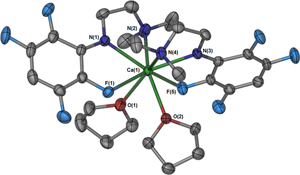
Calcium and magnesium complexes with N,N-dialkyl-N′-2,3,5,6-tetrafluorophenylethane-1,2-diaminate, p-HC6F4N(CH2)2NR2(1–) (LRH; R = Me or Et), ligands were prepared, characterised, and shown to exhibit Ae–F(C) bonding. Prolonged heating of the complexes in C6D6 at 80°C showed no evidence of C–F activation.
CH13374Anti-Leishmanial Activity of Novel Homo- and Heteroleptic Bismuth(III) Thiocarboxylates
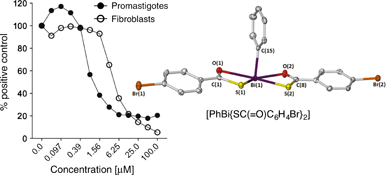
Eleven homo- and heteroleptic bismuth(iii) thiobenzoates of form Ph3–nBiLn (n = 0–3) have been synthesised and evaluated alongside their parent thiocarboxylic acids for inhibitory activity against the Leishmania parasite. The tris-thiocarboxylate complexes (BiL3) proved to be significantly less active (100 µM) than the monophenyl analogues (PhBiL2), which were active in the range 0.39–4.69 μM.
CH13263The Synthesis and Structures of Tris(2-pyridylseleno)methyl Zinc Compounds with κ2-, κ3-, and κ4-Coordination Modes
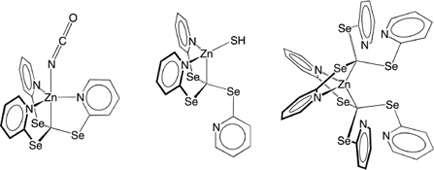
Tris(2-pyridylseleno)methane, [Tpsem]H, has been employed to synthesize a variety of zinc complexes, namely [κ3-Tpsem]ZnN(SiMe3)2, [κ4-Tpsem]ZnNCO, [κ3-Tpsem]ZnSH, {[κ3-Tpsem]Zn}2(μ-S), [κ2-Tpsem]2Zn, and [κ4-Tpsem]Zn(κ2-SeC6H4N), thereby demonstrating that the [Tpsem] ligand can exhibit κ2-, κ3-, and κ4-coordination modes.
CH132651,2-Disilabicyclo[1.1.1]pentan-4-ones from a Disilenide and Acryloyl Chlorides

Reactions of a disilenide, a disila analogue of vinyl lithiums, with two α,β-unsaturated carboxylic acid chlorides yields the first examples of compounds with a bicyclo[1.1.1]pentane scaffold that feature one carbon and one silicon atom at bridgehead positions.



